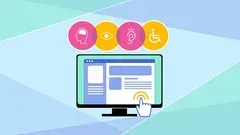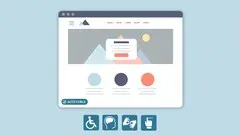
Web Accessibility: Learn Best Practices Tools & Techniques

Are you a website designer/developer or UX designer? Do you want to stand out from the crowd and add value to your clients? U1 Group's Web Accessibility course is the perfect way to do just that. With 12 modules, 10 downloadable 'cheat sheets', and unparalleled accessibility expertise, this course will provide you with the tools and techniques to confidently develop accessible websites. Learn how to apply guidelines to common aspects of websites, optimise the use of colour, create more accessible forms, and enhance the accessibility of dynamic and rich internet content. Don't risk marginalising up to 20% of your website's visitors - join this course and gain a competitive advantage today!▼
Course Feature
![]() Cost:
Cost:
Paid
![]() Provider:
Provider:
Udemy
![]() Certificate:
Certificate:
Paid Certification
![]() Language:
Language:
English
![]() Start Date:
Start Date:
2015-04-14
Course Overview
❗The content presented here is sourced directly from Udemy platform. For comprehensive course details, including enrollment information, simply click on the 'Go to class' link on our website.
Updated in [July 18th, 2023]
This course, Web Accessibility: Learn Best Practices Tools & Techniques, provides an overview of the best practices, tools, and techniques for creating accessible websites. Participants will learn about the importance of website accessibility, the Australian Bureau of Statistics' 2003 report on disability, and how to practically apply guidelines to many common aspects of websites. The course includes 12 modules, 10 downloadable 'cheat sheets', and meaningful tools which will allow participants to confidently develop accessible websites. Topics covered in this course include: a crash course in accessibility, ensuring website navigability, creating accessible text content, applying accessibility techniques to multimedia content, optimising the use of colour to enhance accessibility, creating more accessible forms, guidelines for creating accessible images and non-text elements, designing and implementing accessible HTML tables, enhancing the accessibility of dynamic and rich internet content, and guidance on selecting an accessible content management system (CMS). This course is ideal for those involved in UX design or website development, as it provides the knowledge and tools necessary to create accessible websites and avoid potential litigation.
Pros & Cons
-

Comprehensive coverage of accessibility fundamentals: Users appreciate that the course covers all the fundamentals for web accessibility, providing a great introduction to the topic. Suitable for beginners: Users with limited coding backgrounds found the course to be perfect for their needs. They were able to follow along, even when the course delved into HTML and CSS.
-

Outdated content: Some users mentioned that the course needs to be updated to meet the standards of 202They felt that the information provided was based on older guidelines and may be missing newer information. Lack of practical examples and tools: Users expressed a desire for more practical examples and tools to assess WCAG compatibility. They found it lacking that the course mentioned these resources but did not provide any examples or demonstrations.
Course Provider





